


“Every moment is a fresh beginning.“
T.S. Eliot
When the winds of change blow, some people build walls and others build windmills.
 Chinese Proverb
Chinese Proverb




“Every moment is a fresh beginning.“
T.S. Eliot
When the winds of change blow, some people build walls and others build windmills.
 Chinese Proverb
Chinese Proverb
Sangeeta Malkhede and Rachna Sirohi share the aspirations and the roadmap for the organization.
–
“We remain committed to fostering a culture that is conducive to collaboration and innovation. In 2023, we aim to enrich the existing systems and internal processes, unleash a High-Performance culture and build Thought Leadership.”
Hari G writes about how Hyperautomation will enable businesses to gain competitive advantage by delivering significant business value through measurable ROI. – “Hyperautomation is the use of technology to modernize each and every process in a company. It will enable the company to run repetitive processes without any manual intervention.”
Sanjhal Jain writes about how gamification is being used to improve patient engagement and drive toward improved health outcomes. – “By influencing the behaviour of patients, gamified applications help encourage healthy habits thereby leading to better disease management and improved health outcomes. ”
Sundarmoorthy S throws light on a common technique used to compromise cybersecurity and how to defend against it. – “In most of the attack surfaces, the key medium of the attack is the communication between the Attacker and user. The attacker encourages the user to share the private information of self and/or business to compromise themselves for the attack.”
Akshayaa S writes about how we can change our life if we make a few changes in our beliefs. – “Our beliefs are formed over several years with different kinds of experiences we go through. The environment, relationships, situations, exposure and so on molds the kind of beliefs we carry forward.”
Shivakumar D explains the key provisions of the recently introduced Digital Personal Data Protection Bill in India. – “It is a comprehensive legal framework, and its purpose is to provide for the processing of digital personal data in a manner that recognizes both the right of individuals to protect their personal data and the need to process personal data for lawful purposes.”
Team enGAge wishes everyone a Happy New Year!
Talking about the new year and new things brings me to ChatGPT. Yes, it’s all over the news and has extracted a range of reactions, fascination, fear, and everything in between.
OpenAI recently introduced ChatGPT, a long-form question-answering AI that answers complex questions conversationally. It’s a generative AI system that has been fed with a vast amount of data and answers questions based on that data. Its surprisingly articulate and improves upon its answer upon given feedback. From essays, poems, screenplays to code, its ability to generate content has dazzled many. Even though it isn’t always accurate or coherent, it’s a big step ahead in generative AI and has multiple potential applications.
However, many have pointed out areas of concern. It can become a powerful way to spread misinformation, plagiarize content or inventions and propagate human biases that it has been fed. Concerns have been expressed over its use to cheat in exams, write malware and even make some jobs obsolete.
New technology or new applications of technology always bring with it various apprehensions. It will serve us well to evaluate which ones are worth sweating over. While it may make some jobs obsolete, it may create newer job roles. Humans must work in conjunction with technology to check the misuse of such technology and update themselves to keep up with the times.
While countries have been coming up with regulations for high-impact AI, experts believe that general-purpose AI (including generative AI) has been left out. When Europe’s new regulatory rules were proposed in April 2021, there was no single mention of general-purpose, foundational models. But now that our understanding of the future of AI has radically changed, its imperative for these regulations to be revised. Attributing moral responsibility for outcomes has been a challenge in algorithmic societies. It is important to act fast to not let any misuse of technology go unchecked. We have an insightful line up of articles in this edition.
Our Global Head of HR, Sangeeta Malkhede and Senior Talent Management Leader, Rachna Sirohi, have penned their vision for the organization. – “We remain committed to fostering a culture that is conducive to collaboration and innovation. In 2023, we aim to enrich the existing systems and internal processes, unleash a High-Performance culture and build Thought Leadership.”
Hari G has written, ‘Hyperautomation in Healthcare Industries’.

Sanjhal Jain has written, ‘Gamification: Next Big Frontier in Healthcare?’
Sundaramoorthy S has written, ‘Enhancing IT Network Immunity to defend against Social Engineering Attacks’

Shivakumar D has written, ‘Decoding India’s Digital Personal Data Protection Bill, 2022’
Akshayaa S has written, ‘The Power of Our Mind’
Happy Reading!


An international research team has now developed an end-to-end neural network that, in conjunction with the IoT technology, detects object with high accuracy (> 96%) in both 2D and 3D. The new method outperforms the current state-of-the-art methods and the way to new 2D and 3D detection systems for autonomous vehicles.
A new gelatinous robot made with water-based gels and powered by nothing more than temperature change and clever design, brings “a kind of intelligence” to the field of soft robotics. Creators envision ‘gelbots’ crawling through human bodies to deliver medicine.



Researchers from Okinawa Institute of Science and Technology, Japan have shown that they can use AI to discover stabilizing pulses (of light or voltage) in an optimized way to appropriately cool a micro-mechanical object to its quantum state and control its motion. The work showcases the utility of artificial machine intelligence in the development of quantum technologies.
A new technique enables artificial intelligence agents to think much farther into the future when considering how their behaviors can influence the behaviors of other AI agents, toward the completion of a task. This approach improves long-term performance of cooperative or competitive AI agents.
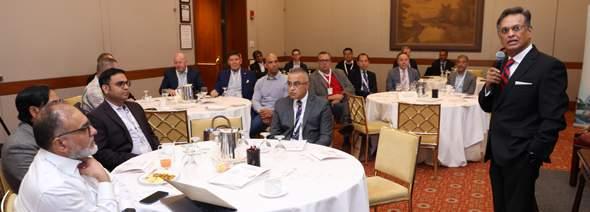


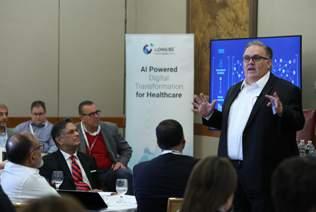



“May you live in interesting times.” – English translation of an ancient Chinese saying. How many times have we been advised to look at the brighter side of things when situations aren’t favorable? And how many times have we consoled ourselves by saying the same thing?

Whatever may your numbers be (if that’s even possible to count!), leaders around the world have had to truly live by it in the last few years.
The true test of a leader’s ability to turn challenges into opportunities is NOW. The pandemic has had a ripple effect on the way the world operates and offered an opportunity to reimagine it. With a rapidly evolving landscape, its imperative to lead with a Transformational mindset. Not only should we be resilient, but also embrace change and grow.
With this context, we organized our annual client event, enGAge, at the Harvard Club of New York, last month. We had some eminent personalities join us to lead the discussion on ‘Addressing and Transforming Challenges’ with their personal and professional experiences. Together they discussed the current imperatives, areas that require transformation and how technology can be leveraged to meet our aspirations.
The business sessions were kicked off by the first Keynote Speaker, Prof. Deepak Malhotra, Eli Goldston Professor of Business Administration at Harvard Business School and Author. Prof. Malhotra’s latest book, The Peacemaker’s Code, is currently being developed as a TV series. He spoke about how CXOs need to understand the importance of negotiation in every function. As an empathetic leader, we must understand other’s points of view and make it a win-win situation. In business and in life, we must treat and communicate with others as our equals.
The second Keynote session by Tom Godden, Enterprise Strategist, AWS, was on ‘How not to sabotage your transformation’. Tom engaged the audience with insights from the strategies that are followed in AWS. He started off with the obvious but often underestimated step of knowing where we’re heading. He explained the importance of having small, efficient teams (2 pizza teams as they call it in Amazon) and ensuring that employees are explained their roles and larger impact to help them get over the ‘Line of Inertia’. He also shared why it’s important to free up employees from mundane and ‘utilitarian’ tasks and have them focus on novel and innovative projects.
We had a special presentation by Julia Zhou, CIO of Community Behavioral Health. She shared an inspiring and moving story of her journey to the summit of Mt. Everest. Her story, replete with photos and videos, truly moved the audience. Her grit and tenacity are a motivation for us to keep going even in the most difficult of times. From growing up in a humble home in the ocean town of Dalian in north-eastern China to standing tall as a renowned figure in healthcare IT, hers is a story of continued determination and resilience.
The final session was a panel discussion with Stephen Grubbs, President & CEO, Covenant Health, Imran Warrich, Former CTO, SC Johnson Company, Suresh Srinivasan, CTO, NYU Langone Medical and Sarah K. Diamond, Former Global MD, Financial Services, IBM & Advisor, moderated by Sumit Ganguli, CEO, GS Lab | GAVS. The panelists spoke about their respective organization’s vision, the challenges that keep them up at night and what can be done to address it.
The panelists agreed on the fact that the vision and aspirations of organizations today have evolved and are focused toward greater good and mitigating issues plaguing the world. Maximizing shareholders’ value is no longer the only guiding principle. The leaders today must take wise decisions and meaningful investments. Being purposeful in our thoughts and action will go a long way in addressing some of our imminent challenges. The issues with attracting and retaining the right talent remained a common theme in the discussion with the leaders suggesting that while no one has figured it out, we must redefine the problem and leverage technology to resolve it. Innovation is most definitely the key to navigate through uncertain times.
We are grateful to all those who attended the event and worked tirelessly behind the scenes to make this event a success.





Global Head of HR, GS Lab | GAVS
Sangeeta Malkhede- heads our global HR team. A senior HR leader with strong convictions, values, and experiences, she has an innovative approach towards HR practice and has held leadership roles at companies like Patni Computer Systems, CSS Corp, Matrimony.com , among others. One of her primary focus areas as Head of HR is to drive a customer-first mindset in employees and programs, enhancing work productivity and engagement. Sangeeta is an avid reader and a keen observer of human behavior.
Talent Management Leader, GS Lab | GAVS
Rachna Sirohi- has spent close to 18 years in the field of Human Resources. Her passion lies in the growth of individuals and organizations. A firm believer in processes and scalable operative mechanisms, she likes the challenge chaos brings in and sets that in order. She is a Certified DiSC Assessor & Trainer, Post Graduate Diploma holder in Human Resource and Personnel Management, and has a Degree in Labour Law, all of which gives her the right knowledge to apply her skills in her role at GS Lab | GAVS.
We wish everyone a happy and healthy new year!
2022 has been a milestone year as we joined hands to become GS Lab | GAVS, and indeed, we are Stronger Together ever since. Coming together not only meant multiplication of innovations and opportunities but also stepping on to avenues with endless possibilities.
We aspire to be a force to reckon with and empower our customers in their journey to achieve their goals and business imperatives. It is our endeavor to do so by being a purposeful and value-driven organization. At GS Lab | GAVS, we ensure all our interactions, thoughts, and actions are based on the RITE (Respect, Integrity, Trust, Empathy) values.
We remain committed to foster a culture that is conducive to collaboration and innovation. In 2023, we aim to enrich the existing systems and internal processes, unleash a High-Performance culture and build Thought Leadership.

Developing our people will remain our priority. We are concentrating our efforts toward fostering a highperformance culture and that starts with aligning everyone to our goals and empowering them to succeed. While we have always focused on effective two-way communication, we will be revamping our feedback processes to ensure we have the pulse of our diverse workforce throughout the year.
Learning and Development initiatives are going to take the front seat to drive the high-performance culture. We will emphasize on upskilling and reskilling our colleagues to help them grow and contribute to the growth of our organization. We will be bringing in best-in-class trainers and experts to fuel our growth. We’re also betting on Behavioral and Leadership development programs to be among the key drivers of change.
Members of our recently revamped Top Talent Program, the Galvanizers, will be nurtured to play a crucial role in the transformation and advancement of our organization. As part of this program, each Galvanizer will be part of a core circle headed by a member of the Leadership team, that will work towards a specific strategic initiative. As purveyors of the high-performance culture at GS Lab | GAVS, we expect them to keep challenging us all to aim for the stars.
Inclusion and diversity shall remain one of the agendas to promote a safe, healthy, and conducive ecosystem. GS Lab | GAVS is also committed to be among the Prime Employers of Women. We continue to have vibrant discussions with our women
community, known internally as Sheroes, to become a more diverse and inclusive workplace. We keep refining our policies and benefits to support them better each year.
Through our Role Model Series, we provide a platform for our Sheroes to interact with eminent women leaders and learn from their experiences. We also mentor our women colleagues to enable them to navigate through the complexities of work and life and keep advancing. This year we will be organizing more women-specific hiring drives as well. On-boarding the right talent, grooming them to embrace opportunities and helping them deliver will be done through associating with Global Institutions and Universities.
It is our goal to emerge as a great place to work and we recognize the significance of employee wellness to achieve that. We believe our hybrid work model, flexible timings, wellness sessions with experts, health camps, health insurance are some of the pillars of ensuring the physical well-being of our colleagues. We also have a comprehensive Employee Assistance Program, Reach Out, and an in-house psychologist, to spread awareness about mental health and offer help when needed. We realize that in a rapidly changing world, each of us may experience stress and negative emotions at various points and through different triggers. We will keep sensitizing everyone to be mindful and reach out whenever they need to.
We thus begin the year with aspirations to carve a niche that becomes a benchmark in the years to come. Competencies across the board are vast and we together would strive to imbibe and harness all of those in the engagements with our stakeholders. As an organization we keep learning and unlearning to move ahead, and we invite people to join us in this exciting journey and grow along with us.
Organizations today want to increase productivity, minimize expenses, and aim to work most efficiently to succeed. Hyperautomation is one of the solutions which can help organizations move ahead. In this article, I’ll explain the usage of hyperautomation in healthcare industries.

Hyperautomation is the use of technology to modernize each and every process in a company. It will enable the company to run repetitive processes without any manual intervention. Hyperautomation uses RPA (robotic process automation), ML (Machine Learning) & AI (Artificial Intelligence) to modernize legacy processes. It can help an organization to achieve resource and cost efficiencies to succeed in a competitive landscape.
Automation targets to perform the repetitive task on a smaller scale without any manual intervention by creating solutions to focus on individual tasks. On the other hand, hyperautomation refers to the effective use of multiple corresponding technologies to enable intelligent automation and to provide end-to-end automation.


Due to COVID-19, digitization for delivery of patient care has increased. Patients want easily accessible, transparent, faster, and personalized healthcare. As hyperautomation focuses on end-to-end automation, it improves the patient experience. Hyperautomation not only makes the process faster, but it also frees up resources, so they can focus on providing valuebased services to patients.
According to Gartner, hyperautomation is unavoidable and is soon becoming a requirement for survival instead of a choice for organizations.
• Outdated systems: Around 80% of healthcare providers use legacy systems which are obsolete and outdated, and only 12% of the organizations use digital transactions. It is difficult to replace these systems as it can cause integration issues and can disrupt the operations. Using technologies like screen scraping, OCR (Optical Character Recognition) & hyperautomation, healthcare industries can integrate older systems to newer ones.
• Holistic view of operations: Systems in the healthcare industry are very vast, complex, and interconnected. They use a mix of legacy and modern technology applications to solve specific challenges. However, this leads to lesser visibility of the holistic view of operations. Addressing the inefficiency of healthcare systems by hyperautomation is gaining attention and impacting the whole spectrum of healthcare operations. Hyperautomation supports organizations. It can bring together a variety of data from multiple sources into a common platform and thereby increase the visibility of entire operations, which can help the service providers to identify specific areas which need improvements.
• Data Management: Healthcare industries has to deal with massive volume of data on daily basis due to Electronic Health Records and digital patient interaction, and they encounter several challenges related to data management:

o Monotonous & exhaustive labor work incur higher operational cost
o Error-prone manual efforts lead to regulatory and operational barrier

o Fragmented workflows of legacy systems
o Lesser transparency due to vast and patchy processes
can also be predicted using predictive analytics. All these together can bring about a revolution in patient care.
• Experience of Patient: Conversational AI and process automation tools can improve the patient experience. For instance, AI-based chatbots can help the customer support associates to provide faster service and also analyze the data. They can connect with patients to provide self-service scheduling, sending notification, collecting information which will allow healthcare providers to investigate effectively. This is secured, user-friendly and more easily accessible than legacy EHR systems, reducing the cost of operation and data fraud.
• Lab automation: RPA and enhanced system automation instrumentation in lab processes. It will speed up the laboratory tasks which take a lot of time, reduce the manual efforts and waste, save costs and improve efficiency.
• Insurance Process in Healthcare: The National Health Care Anti-Fraud Association (NHCAA) estimates that healthcare fraud results in losses of $68 billion to $300 billion. Frauds can be detected more effectively by using AI & ML than manual efforts, as they can easily go through the massive datasets and can understand the behaviour and fraudulent tendencies. Insurance companies can eliminate human mistakes with the help of Hyperautomation. It will also fast track the claims process by cutting down the human intervention required for prior authorization. Clients will be very happy with faster claims.
• Customized health screening: Post pandemicinduced lockdowns and remote monitoring is gaining traction. The data analytics, digital health assistants, wearable & Internet of Things (IoT) are becoming crucial part of health services. For example, wearables and sensors monitor highrisk of blood pressure and sugar levels, while digital health assists in improving the treatment guidelines adherence. Future illness of patients
• Artificial Intelligence-led diagnostics: Hyperautomation with ML, computer vision, and intelligent workflows can provide faster and accurate results. Diagnosis will become speedy by using computer vision and ML. The system can perform the secondary readings automatically and assigns the cases by functional area, specialty, etc. Post verification, diagnostics reports can be delivered directly to doctors, integrating with Electronic Medical Records (EMRs).
Soon, hyperautomation capabilities will gain traction across a wide range of business operations. It will also improve the patient health outcomes as the pandemic continues to speed up the need of transformation in the healthcare industries.
Hyperautomation will also provide fresh business opportunities to gain competitive advantage by delivering significant business value through measurable ROI.
• Hyperautomation in Healthcare - Typical Use Cases and Benefits - Excellarate
• Healthcare Hyperautomation Improving Efficiency | HIMSS
• Healthcare Hyperautomation: Use Cases & Best Practices [2023] (aimultiple.com)
• Hyper Automation in the Healthcare IndustryCelbridgeScience
Hari is part of the Quality Management function at GS Lab | GAVS, handling the Assurance and Delivery excellence. He is driving process improvement activities and Digital transformation project across GAVS. He is passionate about learning new technology. In his free time he likes watching movies and TV shows and spending time with his family.

There is a growing interest to utilize digital tools to improve the quality and availability of care. While remote patient monitoring enables continuous flow of data outside hospitals and proactive responses in emergency situations, telehealth facilitates on-demand access to healthcare professionals.

Another emerging digital tool that is being used to improve patient engagement is gamification. It aims to use challenges and instant rewards to improve patient motivation. By influencing the behaviour of patients, gamified applications help encourage healthy habits thereby leading to better disease management and improved health outcomes.
A growing number of companies and start-ups are offering digital health solutions and platforms to both providers and patients to choose from. Emboldened by their experience as customers in the online shopping, entertainment and consumer markets, patients are becoming more demanding in the healthcare industry as well. However, applications with gamification embedded in them are quickly creating a niche for themselves in the large and complex digital healthcare market. Digital health monitoring is a prime example of an area where gamification strategies can be readily applied. Wearable devices like Fitbit and Apple watches and apps like Strava allow users to not only track and analyze their fitness activities but motivate users and integrate a layer of satisfaction to fitness activities.
The pandemic has greatly affected the rate at which technology has been adopted by healthcare providers. The quarantines have led to a dramatic shift in people’s expectations and lifestyles and increased the demand for services like telemedicine and remote patient monitoring. Furthermore, increased penetration of smartphones and usage of wearables enable the use of gamified products; and linking fitness activities to social networks that drive better engagement through online competition have led to faster adoption of gamified applications.
Multiple players are leveraging gamification to improve participation, engagement, and motivation, consequently increasing patient well-being across the patient journey (preventative care, diagnosis, therapy, and palliative care).
Focusing on Preventive Care StepSetGo: Application rewards users with cash rewards for walking. Other gamification features to drive engagement include tasks which are a list of activities that need to be completed by the user for extra coins which can be redeemed for cash.
Focusing on Therapy
Mango Health: Application sets up daily routines and recommending personalized healthy habits. Additional features include prescription reminders and incentives for medication schedule adherence in the form of points.
Focusing on Palliative Care Nintendo: Applications on the Nintendo platform help improve brain health of senior citizens through engaging games which stimulate the brain.
Focusing on Overall Patient Journey Ayogo: The application is designed to setup personal health plans and track behavioral habits through reminders and recording user behavior.
While the above benefits cases focus on the patient, gamification helps drive better outcomes for healthcare providers as well by allowing them to plan activities and gamified actions for patients. Typical benefits cases include:
• Symptoms and wellness tracking involves use of gamified digital health platforms where patients can engage, monitor health parameters, and track wellness.
• Treatment and ongoing care focus on providers integrating patient behaviour and activity monitoring data from gamified applications into clinical health systems. Physicians can
gain greater insight into symptoms to properly diagnose critical diseases and remotely monitor patient activity and vital health parameters for chronic disease management.
• Appointment scheduling involves combining automatic schedule appointments with gamification strategies to lower patients’ anxiety about health outcomes before their healthcare center visit.
• Medication adherence drives better adherence for prescription medication to encourage ontime consumption of medicines and reduce hospitalization costs incurred by payers due to lack of adherence through use of rewards, points, and other gamified incentives.
• Health insurance linked benefits cases allow payers and providers alike to realise benefits from risk-based payment models by applying gamification strategies to boost physician and case manager engagement within patient tracking to accurately predict at-risk patients.
• Physician engagement linked benefits cases allow healthcare systems to use gamification to reduce common HAIs among hospital units thereby improving overall process quality.
• Revenue Cycle Management: Gamification can also attribute to improved revenue cycle performance by incorporating real time feedbacks and gaming elements to spur employee productivity, create a culture of transparency, and get deep insight into staff performance.
While there are benefits to gamification for both providers and patients, embedding gamification within applications requires a clear strategy and understanding of pre-requisites for successful implementation.
Following are some of the pre-requisites to realize complete benefits of gamification:
• Seamless integration across platforms and other third-party applications
• Leverage data analytics to design personalized patient journey
• Adopt the right gamification strategies to deliver promised results
• Adopt data security and privacy guidelines compliant with patient privacy regulations
Organizations that can support providers in building capabilities to realise pre-requisites outlined above would be able to drive value for their clients and help deliver truly personalized services to the patients.
• https://meticulousblog.org/top-10-companies-inhealthcare-gamification-market/
• https://home.kpmg/ae/en/blogs/home/ posts/2021/08/gamification-in-healthcare.html
• https://emerline.com/blog/gamification-inhealthcare
• https://www.mckinsey.com/industries/ technology-media-and-telecommunications/ our-insights/digital-health-can-gamification-be-awinning-strategy-for-disease-management
• https://digitalhealth.folio3.com/blog/what-wayscan-gamification-be-used-in-the-healthcareindustry/
IT Networks are targeted by multiple type of threats. It’s not just advanced technology that enables such attacks but also gullible humans who unknowingly aid in it. Such type of attacks is known as Social Engineering. Let’s discuss what is social engineering and how to defend IT networks from it.
Social engineering is a manipulation technique which is used to gain access to confidential information, private networks, and privileged information. The attacks could be executed by extracting information from users through a friendly verbal conversation after establishing trust. The victims hardly suspect any ill-intention while being leveraged to extract information. which help the attackers get unauthorized access to networks.

Social engineering attacks are planned around the day-to-day habits/routines of the users like their routines in the work environment. Once the attacker decodes what encourages the users’ actions, they can deceive and operate the compromised user effectively for executing the illegal activities, as the user is not aware of the values of personally identifiable data

such as email id, phone addresses, etc. They can also be lured to click on hyperlinks which would spread malware on their systems.
In most of the attack surfaces, the key medium of the attack is the communication between the Attacker and user. The attacker encourages the user to share the private information of self and/or business to compromise themselves for the attack. The mode of the communication between the user and the attacker could be various.
Following are a few steps involved in social engineering attack surface. Threatening the user with personal and emotional triggers like anger, emergency, fear of termination or suspension of mandatory day-to-day services, tempting the user with free offers and goodies, are some of the situations where the users do not consider the values of sharing the personal details such as credit card, debit card, bank account and personal information. Emotional reaction of the user makes the job of the attacker simpler in compromising the user.
 Sundarmoorthy S
Sundarmoorthy S

of the user. Adaptive authentication plays a key role in safe authentication for handling the modern-day attacks as it uses a dynamic way of identifying the user
Having a strong password policy or password manager will ensure the user passwords are of not compromised easily
Defining the software access policies
Using Virtual Private Networks (VPNs) to give you private, encrypted access to the network
Implementing the concepts of the Zero Trust on physical devices and software applications to the
Ensuring the physical access to the business premises are meeting the governance and compliance guidelines
Implementating RBAC & SoD policies in proactive
1. Validating the identity of the user with whom we are doing business, communications
2. Checking for the authenticity of the attachments and the email we get in our inbox
3. Double checking the content and legitimacy of the offers and discounts which are sent to us
4. Verifying the email address, domain, and social media profiles carefully when we get a message from the suspect
5. Ensure the emotions of emergency, excitement and curiousness are not misused to make us compromised
6. Avoid sharing sensitive information to any stranger about business or self
• Use of Multifactor authentication adds one extra layer of the security upon verifying the identity
While Social Engineering attacks are targeted toward individuals, when compromised, it is possible that it will impact IT Networks. Thus, it is mandatory to ensure that individuals are aware of such techniques to prevent themselves from becoming the victim of it. Organizations must ensure that all employees are given awareness trainings and put measure in place to effectively guard against social engineering.
Sundar has more than 13 years of experience in IT, IT security, IDAM, PAM and MDM project and products. He is interested in developing innovative mobile applications which saves time and money. He is also a travel enthusiast.
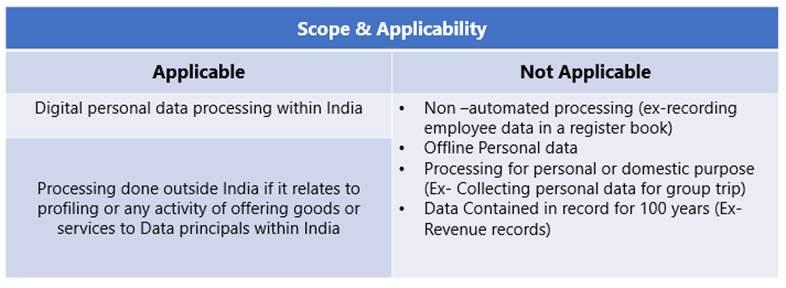
Data protection has continued to remain in the limelight with compliance being the highest priority for every organization since the adoption of GDPR in May 2018. With the rapid growth in data usage all countries are eyeing at drafting a global compliance needs that will safeguard their citizens data. The Indian Government has long been working on a comprehensive data protection law to meet the global practices for data handling and protection. India has recently introduced a draft Digital Personal Data Protection Bill (DPDPB) that provides a legal framework outlining the rights and duties of citizens and the obligations of data fiduciary to collect and use the data in a lawfully manner. This bill has been released for the public consultation and is expected to be introduced in the parliament in 2023.


• With nearly 450 million Internet users and a growth rate of 7-8%, India is well on the path to
becoming a digital economy, which has a large market for global players.
• The need to protect India’s growing start-up ecosystem and smaller companies from the ‘burden’ of compliance costs
It is a comprehensive legal framework, and its purpose is to provide for the processing of digital personal data in a manner that recognizes both the right of individuals to protect their personal data and the need to process personal data for lawful purposes.
It makes organizations/companies accountable for the data they collect, store, analyze, and use.
Below are the 10 key provisions laid out in the draft bill each representing the importance of the data collection and usage in lawful manner.
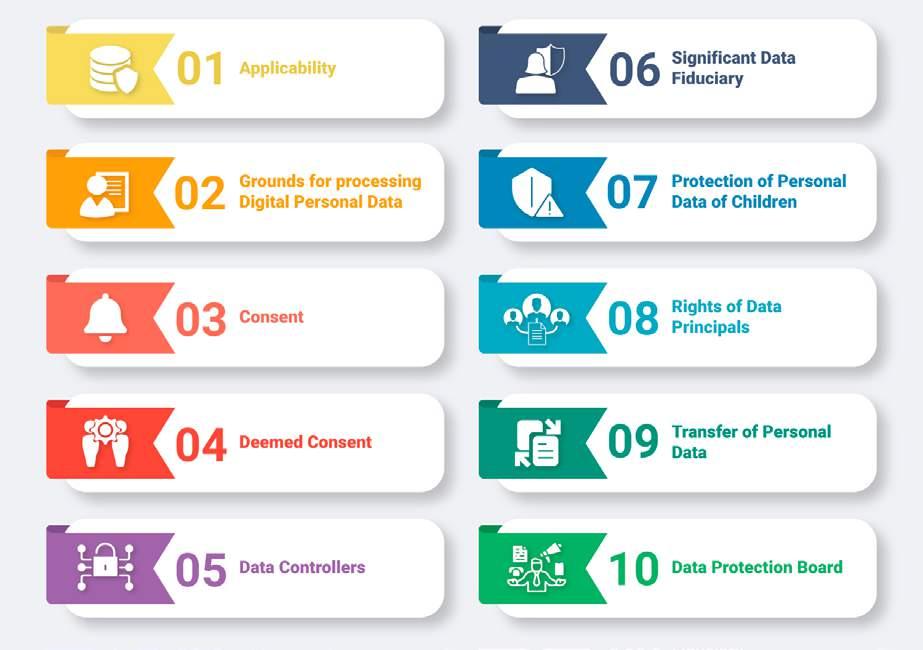
The Rights of the Data Principals is of utmost importance for any global data privacy laws. The DPDPB has also laid out the Data Principal rights -
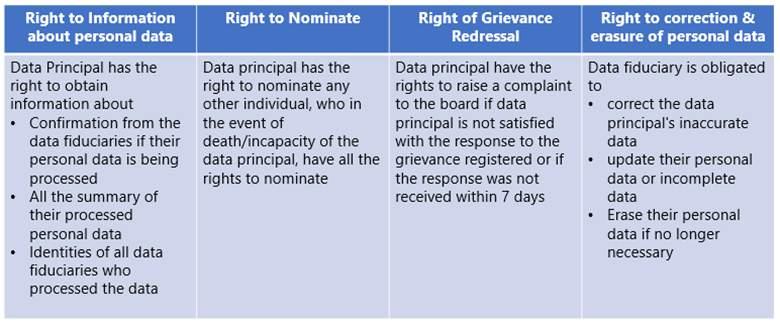
One of the first things organizations look for in the Data Protection Bill is the cost of non-compliance. The DPDPB bill has laid out the penalties in the event of non-compliance as stated below
1. Failure of Data Processor or Data Fiduciary to take reasonable security guards to prevent personal data breach – Penalty up to INR 250 crores
2. Failure to notify the board and affected data principals in the event of data breach - Penalty up to INR 200 crores
3. Non-fulfilment of additional obligations in relation to children – Penalty up to INR 200 crores
4. Non-fulfilment of additional obligations of Significant Data Fiduciary – Penalty up to INR 150 crores
5. Non-compliance with section 16 of this act –Penalty up to INR 10 thousand
6. Non-compliance with provisions of this act other than those listed I 1 to 5 and any rule made thereunder – Penalty up to INR 50 crores
At GS Lab | GAVS, we take a holistic approach on staying compliant with emerging privacy laws. It is important to have a proper understanding of the data flow of any data stored or processed within the organization. This provides a strong base to navigate through managing and implementing complex privacy measures. DPDPB is undoubtedly one of the more comprehensive regulations but is also vague. This leave most organizations having to do the guesswork on interpreting the regulation since it is unchartered territory. Having a robust legal counsel might be one part of the solution to help with law interpretation and avoid speculative approach on the interpretation of the regulation. To go beyond a simple one-size-fits all approach, a company’s privacy leaders must have a strong understanding of the many different privacy laws of relevant jurisdictions. Key areas of difference to focus on include what constitutes sensitive data, limits on automated data processing, legitimate bases for processing data, and the rules of consent, among other things.
An organization must not only strive for external business growth but also look internally to achieve that goal. It is important for a company to encourage innovation and take a holistic view of what would
be the best approach in implementing a particular regulation. This will give rise to new ideas and keep the company fueled with what is necessary to achieve the next business goal.
Shiva has more than 10 years of experience in Operations and Consulting and is leading the Data Privacy function at GAVS. He is passionate about driving innovative solutions around Data Protection. Outside of work he loves to travel and experience new places and culture.
He is driven by this quote - “Your success will be determined by your own confidence and fortitude”.

There are certain aspects of the mind which hasn’t yet been proven by science on how it functions the way it does. The power of our mind is still a mysterious zone which always has something or the other that surprises us. One such powerful resource that we all hold within us is our belief system. How many would believe if someone said that we can change our life the way we want if we make a few changes in our beliefs? Yes, that’s right! If you are looking forward to bringing some changes to your life, you are in the right place.
Our beliefs are formed over several years with different kinds of experiences we go through. The environment, relationships, situations, exposure and so on molds the kind of beliefs we carry forward. The thoughts that are stimulated during such different experiences add on the weightage to an existing belief. Though external factors have a great influence on what we believe, we equally have a great chance to change and replace it with what we want to become/ attract in our life. It starts with a self-analysis after which we choose to hold on to beliefs that are helpful for us and change the ones that are not helpful for our progress.
believes, “Bad things always happen to me” eventually we will end up attracting such situations which are contradictory to what we want in our life. Instead, if one believes “Good things always happen to me”, it helps in attracting more positive events in life. Sounds terrific right? It is a great power that we all have. All it needs is just a little bit of fine-tuning.
Beliefs are great weapons which can be used to destroy our lives, as well as to enrich it, if we know how to use it well. It is a choice that we make to either stay with the already existing beliefs or to recreate our own helpful ones. It all depends on the effort we are ready to make to turn the tables around, making our life so much easier and enjoyable. Once we understand the unhelpful beliefs we are holding on to, we can replace them with helpful ones. So how do we change what we believe deep down?
Every small thought that runs through our mind impacts our beliefs. Though there are so many theories on how thoughts are created, it is proven that we can create more thoughts consciously around what we focus on our day-day life. This means we all have the power to choose the kind of thoughts we want in our mind. Thoughts have a great impact on how we perceive various things that happen around us. This in turn impacts the way we behave in different situations. Our reactions/behavior impact the outcome we face and in turn create stronger thoughts and assumptions related to the experience. This goes on in a loop and the impact that each component has on another continues.
The first step is to understand the various beliefs that we carry within ourselves. If we start noticing our inner voice, we will eventually be able to trace the kind of beliefs that we hold and the impact it has on our life. For example, if a person deep down

Hence, if we focus more on what we want to attract in life, the closer we are getting to it. All we need to do is to understand what we truly want to attract in life and train our mind to focus on it. This can make wonders in our lives if we start applying it daily. This practice not only helps us to attract what we want but also removes the challenges that keep repeating in our lives. Many times, it is our mind that perceives a situation in a problematic way, in turn creating difficulties in dealing with it. Once we learn how to

utilize our mind power, we can turn things the way we want in our life.
As a new year is ahead, many of us might want different things or changes in life. Some of us might want a promotion at work, some of us might be trying to move on from our past, some of us might be wanting more love and care in life, so on and so forth. Having been reminded of the power of mind, it’s time that we start attracting more relationships, events and things that take us closer to our better self and leave behind all disappointments, pain, failures, and all that was stopping us from getting ahead.
For any clarification or support in understanding our beliefs or the practices we can apply to tune it up, feel free to reach out to our in-house counselor via Reach-Out@gavstech.com
Akshayaa Sridhar is a Psychologist with experience in counseling. She has completed her master’s degree in HRD Psychology from Madras University, followed by a specialization in corporate, family & school counseling. She has been working with Corporates such as Accenture and in her personal capacity has been working with private clients too.
She deals with all kinds of relationship issues, improving work productivity/ academic focus, stress management, motivational issues, personal growth & development, family problems and other issues related to managing one’s own emotions, thoughts, and behaviors.
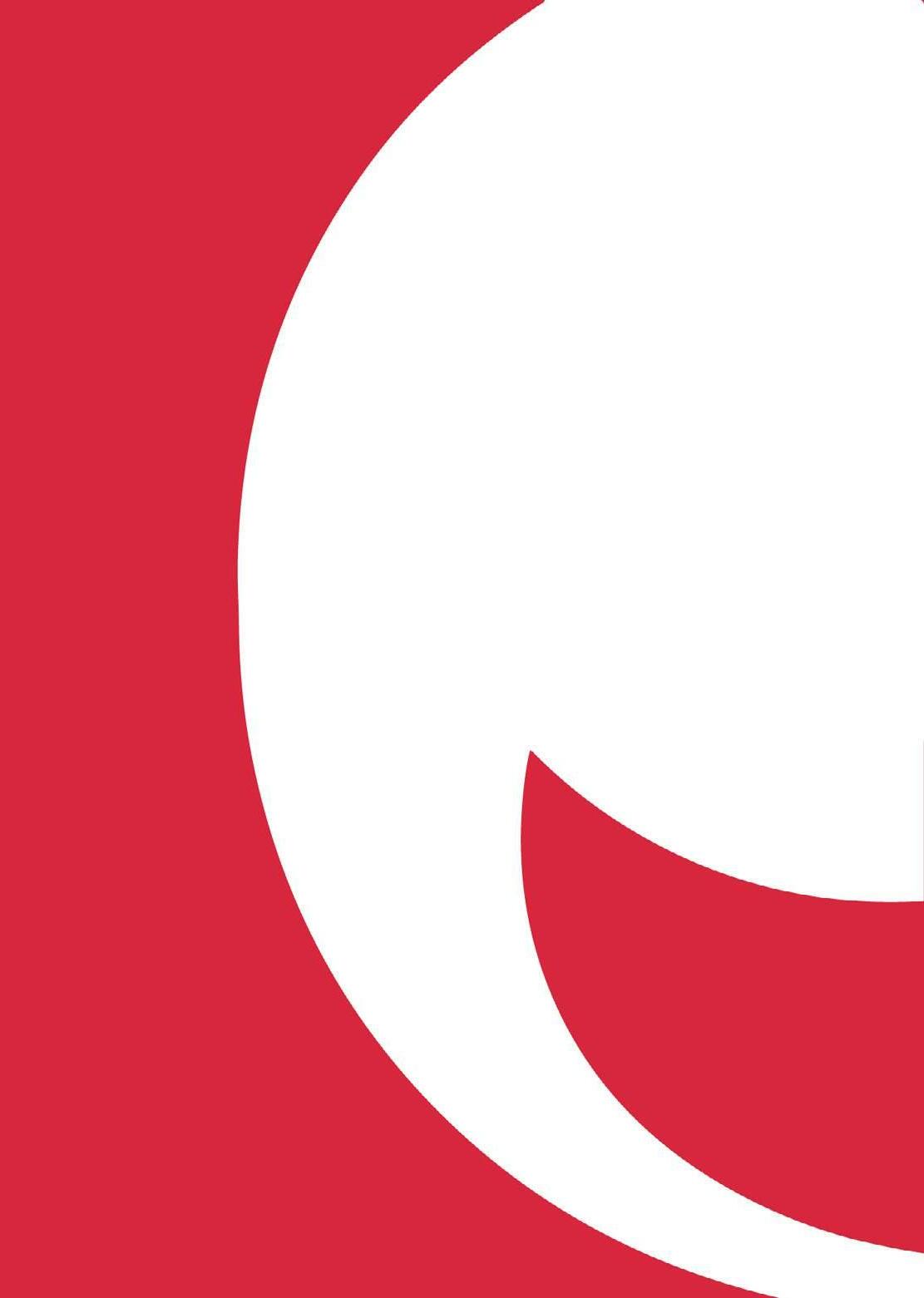
What would life be if we had no courage to attempt anything?





 GAVS Technologies www.gavstech.com
GAVS Technologies www.gavstech.com